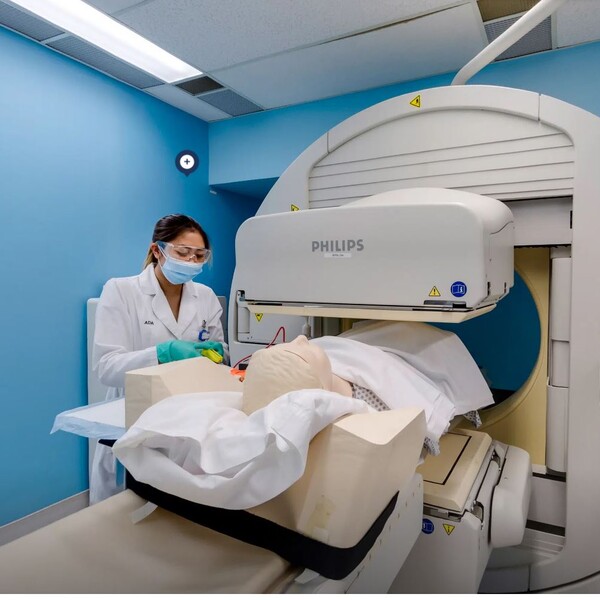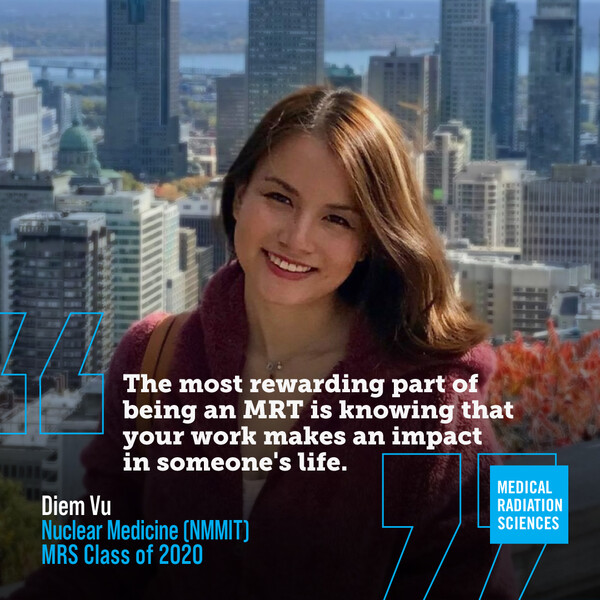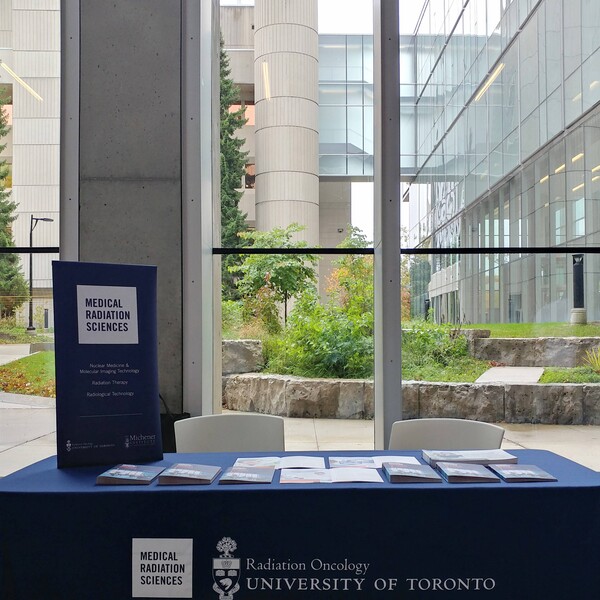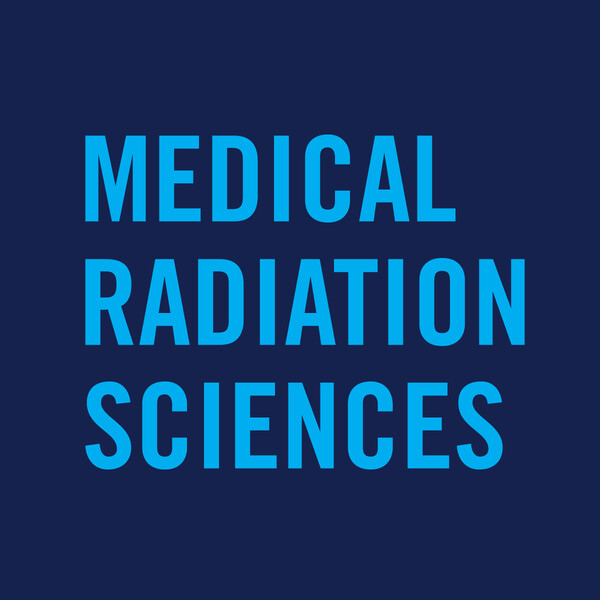Main Second Level Navigation
- Bachelor of Science in Medical Radiation Sciences
- Medical Physics Residency
- Radiation Oncology Residency
- Radiation Oncology Fellowship
- Visiting and Elective Residents and Fellows
- Clinical and Experimental Radiobiology Course
- MR-integrated Radiation Therapy Training Program
- Learner Mistreatment
- Electives and Observerships
- MSc and PhD
- Student Life and Resources
- STARS21
- Teaching Evaluations
Breadcrumbs
- Home
- Education & Continuing Education
- Bachelor of Science in Medical Radiation Sciences
- Nuclear Medicine & Molecular Imaging Technology
Nuclear Medicine & Molecular Imaging Technology
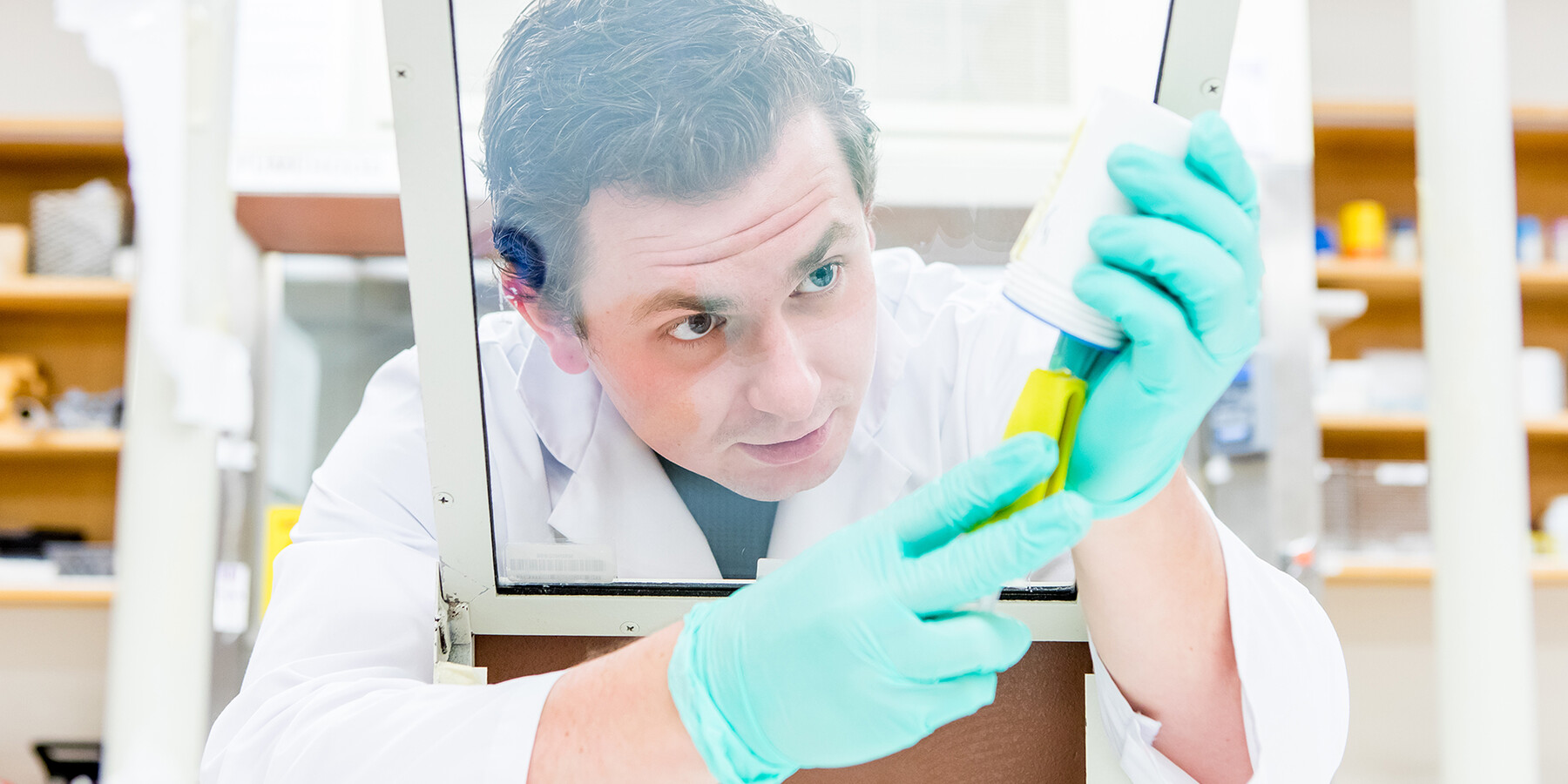
Nuclear Medicine is an imaging method used to safely detect disease in its early stages. The practice of Nuclear Medicine, which includes Positron Emission Tomography (PET), involves the use of radioactive tracers administered either by injection, orally, or inhalation. Special cameras, computers and radioactive tracers are used to image how disease or treatments alter organ system function.
Nuclear Medicine Imaging involves non-invasive procedures that often eliminate the pain and trauma and risk associated with invasive surgery that patients would otherwise undergo, to determine the location and size of tumours, or the extent of numerous diseases in almost all of the human organ systems. It is able to non-invasively image and measure the body’s organs as they function, such as the amount of urine the kidneys produce per minute, the volume of blood ejected from the heart with each beat, and the extent of damage to the heart muscle due to a heart attack.
Molecular Imaging utilizes specialized instrumentation alone, or in combination with targeted imaging agents, to visualize biochemical events at the cellular and molecular level in order to help identify regions of pathology and potential mechanisms of disease.
What does a Nuclear Medicine Technologist do?
Nuclear Medicine Technologists work closely with doctors, and other members of the health care team. Ranging from cardiology to psychiatry, nuclear medicine images and treatments are used by a wide array of medical specialties. Nuclear Medicine Technology can save patients the pain and trauma associated with investigative surgery. The detailed images that nuclear medicine scans produce can determine the location and size of tumours or diseases. Nuclear Medicine Technologists:
- Prepare and administers radiopharmaceuticals to aid in imaging organs and bodily functions
- Use sophisticated computers to process data and enhance images for improved quality
- Analyze biological specimens in the laboratory to aid in diagnosis
Is Nuclear Medicine & Molecular Imaging Technology (NMMIT) a good choice for you?
The discipline of Nuclear Medicine & Molecular Imaging Technology attracts responsible individuals who are people oriented, have a strong desire to provide exceptional patient care and who are attracted to working with high-tech equipment and computer technology.
As a Nuclear Medicine Technologist, you will become part of an interdisciplinary diagnostic imaging team, and could be employed in a variety of clinical environments: community or teaching hospitals, private clinics, research institutes and public health institutions. Your future career opportunities could include research activities, advanced roles such as positron emission tomography (PET), computed tomography (CT), management, education, and sales/marketing. You can pursue further training and certification in magnetic resonance imaging (MRI), and Imaging Informatics, as well as higher education opportunities at a master’s level, and working abroad.
Graduates of the Nuclear Medicine & Molecular Imaging Technology stream of the MRS program will earn a BSc in Medical Radiation Sciences from the University of Toronto and an Advanced Diploma in Health Sciences (Nuclear Medicine and Molecular Imaging Technology) from The Michener Institute. MRS graduates are eligible to write the national certification exam offered by the Canadian Association of Medical Radiation Technologists (CAMRT) and may pursue advanced studies at U of T or Michener, such as:
- Magnetic Resonance Imaging (MRI)
- Master of Applied Science (Institute of Medical Sciences)
- Master of Health Administration
MRS Clinical Placements - NMMIT
NMMIT students gain experience through non-paid clinical placements at one or more sites across Ontario including sites in Brampton, Hamilton, Kitchener, London, Markham, New Market, Ottawa, Sudbury, Thunderbay, Toronto and Windsor*. NMMIT students graduate with 48 weeks of clinical experience:
- 6 week-long rotations in Year 2
- 12 weeks at the end of Year 2
- 30 weeks in Year 3
* Please note that placement at your first-choice site is not guaranteed and that clinical site locations are subject to change.
MRS Course List* - NMMIT
*Subject to Change
YEAR 1 FALL – SEMESTER 1
MRS133H1 / RANM110 – Nuclear Medicine Physics and Radiobiology
This is a course in which students will study the physics and biological effects of ionizing radiation. The scope of this course includes studying the fundamentals of radiation physics related to nuclear medicine, as well as X-ray physics related to CT. Radiation safety and radiation biology will be explored and will include a current and thorough overview of the effects of ionizing radiation on biological systems using case studies and clinical examples.
MRS282H1 / ITNM110 – Integrated Nuclear Medicine & Molecular Imaging I
This foundational course is the first in a longitudinal series of courses specific to the nuclear medicine program, which will cover key concepts, tasks and skills required throughout the program. This course will cover topics of general chemistry and physiology relevant to the study of radiopharmacy as well as general mathematics and physics relevant to nuclear medicine instrumentation and equipment operation. The integrated approach of this course will allow learners to understand the relationship and application of these themes in both didactic and practical applications. The course delivery format is in a hybrid online/onsite approach, combined with both online-based and hands-on experience in laboratory sessions to allow students to learn, explore and apply the concepts of nuclear and molecular imaging.
MRS159H1 / ANAT110 – Anatomy for Medical Radiation Sciences
This is an online course and is designed to serve as a foundation in Human Anatomy for students in the Medical Radiation Sciences (MRS) program. The course is a 0.5 academic credit and will introduce students to the components of the human body, relationships of the surface anatomy and the body's internal components and discuss the basic function of these components. The course will encompass a regional approach to study the human body with correlation to its clinical application. ANRD111 precedes Human Physiology (PSRD120/MRS162H1). It provides the students with an anatomical background prior to learning the regional and systematic functions addressed in the Physiology course. Anatomy for MRS will also serve to prepare students for ANRD121/ MRS164H1 (Relational Anatomy).
MRS227H1/PMRS111 – Patient Care in Medical Radiation Sciences I
This didactic course examines a variety of fundamental patient care topics using a patient-centred lens. Learners will be introduced to the professional, ethical and legal standards which will be reinforced throughout the Medical Radiation Science (MRS) curriculum. Patient care skills will be enhanced through the study of communication, medical terminology, infection control, clinical assessment techniques and relevant pharmacology, including contrast media. This course will also provide the opportunity to develop communication and care-delivery strategies for diverse populations. Reflective practice will be introduced and developed throughout the course as learners work towards becoming reflective practitioners.
This course will provide the learners the opportunity to work with colleagues across the MRS disciplines. A variety of delivery techniques will be used in the didactic setting to promote collaborative and multidisciplinary learning
MRS281H1 / IGRD110 – Comparative Medical Imaging
This course is designed to introduce the learner to the complexities of diagnostic and therapeutic imaging in the healthcare setting. Learners will develop an understanding of what it means to be a medical radiation technologist, a healthcare professional, and to the concept of professionalism. As well, learners will be exposed through a series of seminars delivered by healthcare professionals from the practice setting, to a variety of imaging modalities used in the diagnosis and treatment of patients. Modalities such as X-ray, Computed Tomography (CT), Magnetic Resonance Imaging (MRI), Ultrasound (US), Positron Emissions Tomography (PET), and Image Guidance for Radiation Therapy will be studied. Additional topics relating to the imaging modalities that will be covered are image fusion, radiation safety and dose reduction. In addition, a structured interprofessional education session will be scheduled to explore professionalism in the context of collaboration and communication with other health profession students.
YEAR 1 WINTER – SEMESTER 2
MRS228H1 / PMRS121 – Patient Care in Medical Radiation Sciences II
In this course learners will build upon the knowledge acquired in PMRS111 as they apply the concepts of professional practice, patient management and health and safety, in both the didactic and laboratory environments. Learners will employ principle of infection control, patient assessment, patient transfer, contrast media administration and emergency response procedures. Learners will also be introduced to various venipuncture techniques. These practical skillsets will be developed as learners simultaneously integrate the concepts of patient-centred communication and professionalism introduced in PMRS111.
MRS283H1 / ITNM120 – Integrated Nuclear Medicine & Molecular Imaging II
This course is the second in the four longitudinal series of integrated nuclear medicine and molecular imaging specific core courses. It will use a case-based approach to integrate multiple themes such as radiopharmacy, instrumentation, image quality and take the first look at the methodology of clinical procedures. The clinical methodology topics explored will include the skeletal system, endocrine system, tumors imaging and infections imaging. Additionally, an introduction to PET imaging and instrumentation and the clinical methodology of PET oncology and skeletal imaging will be covered.
The longitudinal nature of the course will encourage reinforcement of key concepts, tasks and skills learned in ITNM110 and carry them through to the next courses in this series. The integrated approach will allow learners to understand the relationship and application of these clinical methodologies in a practical way, using a course delivery method of a hybrid online/onsite delivery of didactic material, combined with significant hands-on experience in laboratory sessions.
MRS164H1 / ANRD121 – Relational Anatomy
For the purposes of diagnosis and optimal treatment of abnormal patient conditions, high quality, detailed images are required in order to obtain information on the anatomical state of an organ or structure within the body. The ability to recognize anatomical structures as demonstrated on CT or MR images in sagittal, coronal and axial sectional planes is essential in the current hospital imaging environment. The Relational Anatomy course investigates gross, cross-sectional and relational anatomy of the head, central nervous system, neck, spine, thorax, abdomen, male / female pelvis, upper / lower extremities. An emphasis is placed upon the organs, the vascular system, the lymphatics system as well as muscular and skeletal structures. This course offers weekly interactive lectures and labs which provide the student with a stimulating environment in which they may actively apply the knowledge learned through the use of a variety of media including anatomical models, preserved human specimens, cadaver cross section images as well as a multitude of hard copy and computer based medical images.
MRS162H1 / PSRD120 – Physiology
This course is an introductory ONLINE course designed to serve as the foundation in Human Physiology for students in the Medical Radiation Science program. It is intended for students who have an interest in or a need for a basic course in Human Physiology. The course is a 0.5 credit course and will introduce students to the function of the organ systems that comprise the human body. The course will follow a systematic structure covering all of the principal functional systems within the body, such as the cardiovascular and respiratory systems. As such students are expected to be familiar with the anatomical structure of these systems. Clinical examples will be used to illustrate key principles and material where possible.
YEAR 1 SUMMER – SEMESTER 3
MRS232H1 / HIRT130 – Health Improvement Initiatives
Health Improvement Initiatives is a 12-week summer semester course that will focus on the intersection of three principle domains of healthcare system, leadership, quality. The course will explore the organization and structure of the Canadian healthcare system to better understand and appreciate the roles and accountabilities of those who use and those who function within it. It will also examine healthcare leadership at all levels and the practitioner needed for today’s dynamic healthcare environment. Lastly, the course will focus on understanding quality improvement initiatives aimed to make healthcare more effective, efficient, and safe.
MRS284H1 / PRNM130 – Nuclear Medicine in Practice
This course will provide learners with the opportunity to further develop practical skills in the areas of venipuncture and patient care while introducing theory and application of bone mineral density, electrocardiogram (ECG) and radiopharmacy. The venipuncture/patient care portion of the course will allow students to strengthen venipuncture techniques that will be used in their practice as nuclear medicine technologists. Laboratory sessions will give learners the opportunity to practice monitoring, recognizing and responding to changes in a patient's physical and emotional status. ECG is an important aspect of nuclear cardiology. This course will act as an introduction to ECG to learn the normal pathway for the conduction electrical impulses in the heart. Finally the radiopharmacy portion will focus on the preparation, dispensing, and shipment of various radiopharmaceuticals. Students will participate in departmental duties associated with both the radiopharmacy environment and a general nuclear medicine department. This includes, but is not limited to, instrument quality control and execution of a radiation protection program
MRS285H1 / PTNM130– PET/CT & Nuclear Theranostics
This course is intended for the nuclear medicine learner to integrate knowledge of molecular imaging to gain a more in depth understanding of the field of positron emission tomography/computed tomography (PET/CT) and the emerging use of theranostic procedures. The approach used in this course will utilize knowledge of instrumentation of PET and hybrid imaging modalities, radiochemistry, radiopharmaceutical synthesis, and radiation physics, and explore in the deeper context of positron imaging and therapeutic delivery. The course will highlight the latest in molecular targeted imaging agents such as those used for neuroendocrine and prostate cancers as well as review important technical concepts in PET/CT imaging in therapeutic nuclear medicine. By the end of the course learners will develop a complex understanding of PET/CT and therapeutic procedures using case studies and virtual simulated clinical experiences, as well as an understanding in the broader perspective on the economic, clinical and academic aspects of emerging trends in PET/CT imaging and nuclear medicine therapy.
YEAR 2 FALL – SEMESTER 4
MRS286H1 / ITNM240 – Integrated Nuclear Medicine & Molecular Imaging III
The third in the longitudinal series of courses will use a hybrid approach to integrate multiple topic themes as they relate to imaging methodologies of the cardiac, respiratory and genitourinary systems. Learners will have the opportunity to reinforce key concepts, tasks and skills acquired throughout the program. The hybrid online/onsite delivery will allow students to learn, explore and apply the concepts of nuclear and molecular imaging in a variety of learning environments.
MRS265H1 / CTRD240 - Integrated CT Imaging Theory and Practice I
CTRD240 is a collaborative course for students in Nuclear Medicine, Radiological Technology, and Radiation Therapy. This course provides students with the opportunity to explore the evolution of computed tomography (CT), the basic physical principles of computed tomography, image formation and display. Students will participate in simulating clinical applications of computed tomography as well as examine radiation safety issues as they pertain to computed tomography. The CTRD240 course consists of two hours of lecture and two hours of lab per week.
MRS266H1 / RMIP231 – Introduction to Research Methods
This course provides an introduction to research methods and designs relevant to practitioners of the medical radiation sciences. This course will focus on an introduction to various research designs including experimental and non-experimental, and quantitative and qualitative research methods. In addition, the course will focus on providing a practical understanding of several basic statistical tools used in medical and health research.
MRS260H1Y / EMRS240 – Experiential Learning in IPEC
"lnterprofessional education (IPE) occurs when students from two or more professions learn about, from and with each other to enable effective collaboration and improve health outcomes" (WHO, 2010). At the academic level, the goal of IPE is to prepare health professional students with the knowledge, skills and attitudes necessary for collaborative interprofessional practice (http://ipe.utoronto.ca/).
Experiential Learning in lnterprofessional Education and Collaboration is a longitudinal, two semesters, course consisting of online asynchronous and synchronous learning activities. Online asynchronous self-directed activities will explore and examine key concepts and skills surrounding IPE, reflection, and communication.
Synchronous experiential learning activities will expose students to other health profession students in various contexts to enable them to better understand health profession roles, appreciate team dynamics in healthcare, and learn with and from each other. Through the various learning opportunities, MRS students will gain valuable collaborate and communication skills to help prepare them to be collaborative practice-ready healthcare professionals. This course is interactive and requires full participation. Students will be required to reflect on course content and activities and prepare a longitudinal portfolio that reflects the values and competencies of interprofessional education and collaboration.
YEAR 2 WINTER – SEMESTER 5
MRS206H1 / CTRD250 – Integrated C.T. Imaging Theory and Practice II
Computed Tomography (CT) is one of the essential competencies required for an entry-level technologist for Radiological Technology in Canada. This course is designed to ensure that students recognize the appearance of common pathologic conditions and anomalies seen on CT scans of the head, neck, chest, abdomen, pelvis, extremities and spine. This course will explore the significance of CT procedures and protocols used to visualize common pathologic conditions and anomalies on CT images. In a simulated setting in the CT suite the learner will manipulate scan protocols and the acquired image data from a prescribed study in preparation for diagnostic reporting.
MRS290H1 / ITNM250 – Integrated Nuclear Medicine & Molecular Imaging IV
The fourth in this longitudinal series of courses will use a hybrid approach to integrate multiple topic themes as they relate to imaging methodologies of the gastrointestinal, central nervous systems and radiopharmacy. This course will also explore current therapeutic applications in the field of nuclear medicine and molecular imaging. Learners will have the opportunity to reinforce key concepts, tasks and skills acquired throughout the program. The hybrid online/onsite delivery will allow students to learn, explore and apply the concepts of nuclear and molecular imaging in a variety of learning environments.
There are three clinical visits in this course. Each clinical rotation is four days long on Monday, Tuesday, Thursday and Friday. Scheduled in weeks 4, 9, & 13. The purpose of the clinical visits is to provide students with:
- An introduction and orientation to the clinical setting.
- Opportunities to interact with clinicians and patients.
- Opportunities to observe and participate in clinical activities.
- Opportunity for learners to consolidate knowledge, skills and judgement within a clinical Nuclear Medicine department.
MRS269H1 / HBRD241 – Clinical Behavioural Sciences
This course provides an overview of the ethical, societal and personal factors that influence and impact health care services. The role of the health care provider and the dynamics of the provider/patient relationship will be examined from a critical perspective. Through an interprofessional education session students will explore alternate models of healthcare provision. This course will combine theory and practical application, allowing the student to reflect on his or her own values and beliefs through case studies, reading and discussion.
MRS260H1Y / EMRS240 – Experiential Learning in IPEC (Continued)
"lnterprofessional education (IPE) occurs when students from two or more professions learn about, from and with each other to enable effective collaboration and improve health outcomes" (WHO, 2010). At the academic level, the goal of IPE is to prepare health professional students with the knowledge, skills and attitudes necessary for collaborative interprofessional practice (http://ipe.utoronto.ca/).
Experiential Learning in lnterprofessional Education and Collaboration is a longitudinal, two semesters, course consisting of online asynchronous and synchronous learning activities. Online asynchronous self-directed activities will explore and examine key concepts and skills surrounding IPE, reflection, and communication.
Synchronous experiential learning activities will expose students to other health profession students in various contexts to enable them to better understand health profession roles, appreciate team dynamics in healthcare, and learn with and from each other. Through the various learning opportunities, MRS students will gain valuable collaborate and communication skills to help prepare them to be collaborative practice-ready healthcare professionals. This course is interactive and requires full participation. Students will be required to reflect on course content and activities and prepare a longitudinal portfolio that reflects the values and competencies of interprofessional education and collaboration.
YEAR 2 SUMMER – SEMESTER 6
MRS292H1 / CLNM262 – Nuclear Medicine Clinical Practicum I
This is the first in a series of three clinical practical courses that are a continuation of the clinical component in the Integrated Nuclear Medicine and Molecular Imaging curriculum.
The objective of the CLNM262 course is to develop a working rapport with both the clinical staff and the patients while maintaining good safe working habits. The learner will be working directly with the supervising technologist and will be assisting the technologist to complete tasks and procedures required for the department and for the patients.
The learners will interact with patients and other healthcare providers and have the opportunity to further develop interprofessional, problem solving and critical thinking skills. They will function as an important member of the health care team and must adhere to the standards of practice set in place by the College of Medical Radiation and Imaging Technologists of Ontario (CMRITO) and the code of conduct policies at their clinical sites. The attainment of competencies as outlined in the Canadian Association of Medical Radiation Technologists (CAMRT) competency profile, are the core requirements of this course. It is important for the student to recognize that each clinical facility is unique and as such, no two students’ clinical experiences can be expected to be identical. However, the Medical Radiation Sciences Program has set the minimum rotation criterion to help ensure parity from student-to-student and facility-to-facility during this learning experience.
While the student is expected to successfully complete the course competencies outlined in this document, they are not restricted to these tasks. The student may have the opportunity to participate in additional learning activities not explicitly outlined in this document, which will be arranged at the discretion of the Clinical Coordinator at each clinical site.
Selective II
The specialized electives (“selectives”) are courses developed with the purpose of providing graduates of the Medical Radiation Sciences (MRS) Program with knowledge and expertise in specialized fields of practice. Selectives are designed to give students some freedom in constructing a curriculum that responds to their own particular interests related to their chosen profession and/or academic endeavors after graduating from the program.
Examples of selective courses that are available to MRS students are: MRI, Informatics, Introduction to Brachytherapy, Patient Education, Supportive and Palliative Care, and many more.
YEAR 3 FALL – SEMESTER 7
MRS293H1 / CLNM371 – Nuclear Medicine Clinical Practicum II
This is the second in a series of three clinical practical courses that are a continuation of the clinical component in the Integrated Nuclear Medicine and Molecular Imaging curriculum.
The objective in CLNM 371 is to build upon the interpersonal and professional skills developed from CLNM 262 and expand the learners’ skill set to include more advanced patient care skills and technical imaging skills. The learner should be performing relevant competencies with only moderate supervision, with added assistance from the technologist to ensure that the competencies are performed in a timely manner, while maintaining a safe working environment.
Learners will continue to interact with patients and other healthcare providers and have the opportunity to further develop interprofessional, problem solving and critical thinking skills. They will function as an important member of the health care team and must adhere to the standards of practice set in place by the College of Medical Radiation and Imaging Technologists of Ontario (CMRITO) and the code of conduct policies at their clinical site. The attainment of competencies as outlined in the Canadian Association of Medical Radiation Technologists (CAMRT), are the core requirements of this course.
It is important for the student to recognize that each clinical facility is unique and as such, no two students’ clinical experiences can be expected to be identical. However, the Medical Radiation Sciences Program has set the minimum rotation criterion to help ensure parity from student-to-student and facility-to-facility during this learning experience.
While the student is expected to successfully complete the course competencies outlined in this document, he/she is not restricted to these tasks. The student may have the opportunity to participate in additional learning activities not explicitly outlined in this document, which will be arranged at the discretion of the Clinical Coordinator at each clinical site.
MRS398Y1 / RMRD370 – Research Methods
This two-semester course is the practical component of the Introduction to Research Methods course (MRS265H1/RMIP240). It allows for the completion of a clinically based research project under supervision. The research question and subsequent project may be pre-determined by the clinical research supervisor as it will most likely pertain to the supervisors' research area of interest and clinical expertise. Students will be matched with a research supervisor at their clinical host site to facilitate the development of a clinically relevant and feasible research study.
Delivery and support of this course is principally on-line and at a distance. However, students may be required to present assignments in-person or via live-electronic media in the winter semester of the course. The opportunity to meet in-person or on-line will assist in establishing a collegial research network and community amongst the learners. Completion of the research project will culminate in the submission of a written research thesis. Students will be encouraged to complete work of publishable quality.
This course is recommended for students who are interested in pursuing graduate studies and/or an academic career in Medical Radiation Sciences
- OR -
MRS397H1 / RPRD370 – Research in Practice
Research in Practice is a one semester online course designed to provide an opportunity for learners to critically examine the role that research plays in informing and advancing practice. Through an inquiring examination of clinical practice, the learner will gain an appreciation for evidence-based practice and research. The course consists of independent self-directed assignments in which the learner will review and critically appraise a procedure/guideline from practice (imaging, therapeutic, patient, safety), generate questions and rationale for further investigation, and conduct a search of current literature that leads to a written review of evidence-based practice.
YEAR 3 WINTER – SEMESTER 8
MRS295H1 / CLNM381 – Nuclear Medicine Clinical Practicum III
This is the third and final clinical practical course.
The objective of CLNM 381 is to build upon the clinical skills developed in CLNM 262 and 371 to further develop the knowledge, skills and judgement required for “entry to practice”. At this point, the learner should be well accustomed to the workflow in their departments and working independently and safely with minimal supervision. The competencies performed are of a high level and performed within a reasonable amount of time.
Learners will continue to interact with patients and other healthcare providers and have the opportunity to further develop interprofessional, problem solving and critical thinking skills. They will also function as an important member of the health care team and must adhere to the standards of practice set in place by the College of Medical Radiation and Imaging Technologists of Ontario (CMRITO) and the code of conduct policies in their respective clinical sites. The attainment of competencies as outlined in the Canadian Association of Medical Radiation Technologists (CAMRT), are the core requirements of this course.
It is important for the student to recognize that each clinical facility is unique and as such, no two students’ clinical experiences can be expected to be identical. CLNM 381 has a set minimum rotation criterion to help ensure parity from student-to-student and facility-to-facility during this learning experience. While the student is expected to successfully complete the course competencies outlined in this document, he/she is not restricted to these tasks. Opportunity to participate in additional learning activities not explicitly outlined in this document may arise and be arranged at the discretion of the Clinical Coordinator at each clinical site.
MRS398Y1 / RMRD370 – Research Methods (Continued)
This two-semester course is the practical component of the Introduction to Research Methods course (MRS265H1/RMIP240). It allows for the completion of a clinically based research project under supervision. The research question and subsequent project may be pre-determined by the clinical research supervisor as it will most likely pertain to the supervisors' research area of interest and clinical expertise. Students will be matched with a research supervisor at their clinical host site to facilitate the development of a clinically relevant and feasible research study.
Delivery and support of this course is principally on-line and at a distance. However, students may be required to present assignments in-person or via live-electronic media in the winter semester of the course. The opportunity to meet in-person or on-line will assist in establishing a collegial research network and community amongst the learners. Completion of the research project will culminate in the submission of a written research thesis. Students will be encouraged to complete work of publishable quality.
This course is recommended for students who are interested in pursuing graduate studies and/or an academic career in Medical Radiation Sciences
- OR -
Selective III
The specialized electives (“selectives”) are courses developed with the purpose of providing graduates of the Medical Radiation Sciences (MRS) Program with knowledge and expertise in specialized fields of practice. Selectives are designed to give students some freedom in constructing a curriculum that responds to their own particular interests related to their chosen profession and/or academic endeavors after graduating from the program.
Examples of selective courses that are available to MRS students are: MRI, Informatics, Introduction to Brachytherapy, Patient Education, Supportive and Palliative Care, and many more.

